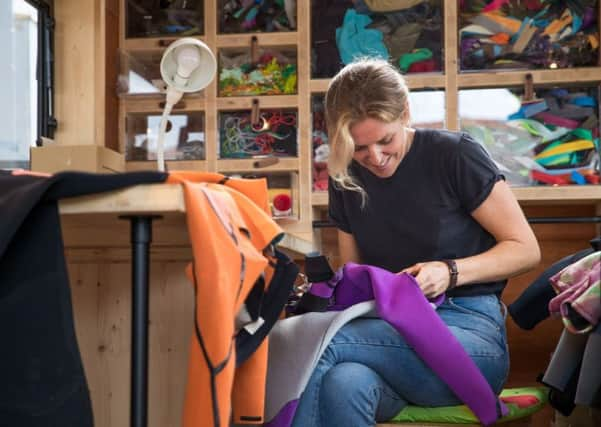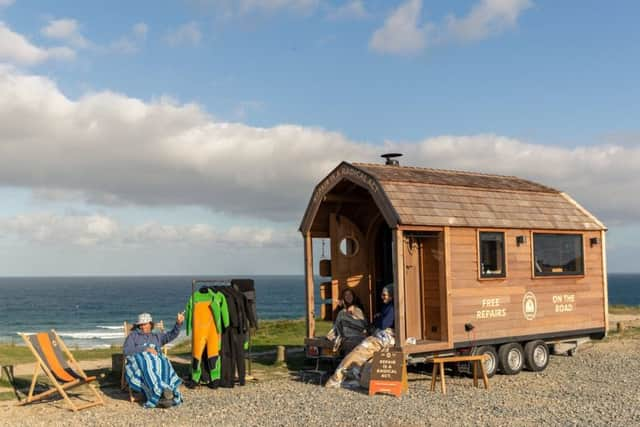Patagonia’s needlework ninjas to teach westuit repair 101 in Dunbar


The folks at Patagonia don’t want people to stop surfing in cold places, but – in line with the philosophy of their activist founder Yvon Chouinard – they do want to help coldwater surfers reduce their carbon footprints, and one way in which they are trying to do this is by making all their wetsuits out of Yulex, a material that incorporates a form of natural rubber harvested from sustainably managed plantations.
These wetsuits don’t come cheap – Patagonia’s top-of-the-range winter fullsuit with integral hood currently costs £500, compared to around £300 for an equivalent neoprene suit made by another leading brand – but Hubbard is quick to point out the environmental benefits:
Advertisement
Hide AdAdvertisement
Hide Ad“We’ve determined that our wetsuits produce about 80 per cent less CO2 than those made from neoprene,” he says, “and the final product is virtually indiscernible: feels the same, performs the same, repairs the same.”


That last bit – “repairs the same” – leads us neatly on to the other way in which Patagonia are trying to help surfers to green up their act. If the manufacture and transportation of new wetsuits – whatever material they are made out of – produces carbon emissions, it follows that the longer surfers can make their wetsuits last once they’ve bought them, the less impact they’ll have on the environment.
Trouble is, it’s all very well telling people that they should keep their wetsuits for longer, but these are technical bits of kit and difficult to repair without specialist knowledge. Once a wetsuit starts to get worn and torn (and, more importantly, once it starts letting in too much cold water) it’s understandable that many people will simply bin it and get a new one.
This is where Patagonia’s Worn Wear initiative comes in. A great example of a company putting its money where its environmental mouth is, it involves teams of expert gear-fixers holding workshops in surfing communities all around the world, fixing people’s wetsuits for them for free and also educating them about how to do basic repairs themselves. As part of the current Worn Wear tour of Europe, some of Patagonia’s top needlework ninjas will be taking up residence at Belhaven Bay near Dunbar on 12 and 13 September, and if you bring along a knackered suit – as long as it’s dry – they’ll do their best to fix it for you. (They’ll be open from noon until 8pm, and it’s first-come, first served, so get there early to avoid disappointment.)
Elsie Pinniger is one of the expert seamstresses on the Worn Wear tour. In a bid to find out what it takes to revive a dead wetsuit, I asked her for some tips on repairing my own battered steamer.
The good news is that the various small nicks to the suit that aren’t holes yet but soon will be are easy enough to fix. “Black Witch glue will seal the hole up and stop it getting any bigger,” says Pinniger. “It’s best to do this by starting with a small amount and building it up rather than just squirting loads of glue into the hole. You can use a wooden stirrer or something similar to do this and keep it neat.”
Bigger tears, though, like the four-inch rip at the bottom of my suit’s right leg that I keep accidentally putting my foot through, require more serious surgery.
First, says Pinniger, I should rinse the suit in clean water and make sure it’s bone dry. “The next bit might sound scary,” she says, “but with the sharpest scissors you can find you’re going to ‘clean’ the cut. This means making sure the edges are super smooth and you want to keep it as close to the original tear as possible. Once you have a clean edge to work with you take your glue and put a very thin layer along the edge of the neoprene. Let that dry completely and once dry put another very thin layer of glue on the edges. Let this layer go tacky but not dry, and once tacky very carefully rejoin the separated edges.
Advertisement
Hide AdAdvertisement
Hide Ad“After this, you’re going to hand blind stitch, ideally with a nylon thread rather than cotton. You hand stitch the seam but only penetrating half way through the thickness of the neoprene – so don’t go all the way through to the inside of the suit. Do this all along the tear and voila! Done!”
So, time to be brave, find some sharp scissors and put Elsie’s instructions into practice. And if it all goes horribly wrong, well, I guess I’ll just have to join the queue for the Worn Wear trailer when it comes to Dunbar.
For more information about the Patagonia Worn Wear Tour, visit https://eu.patagonia.com/gb/en/worn-wear-tour-dates.html